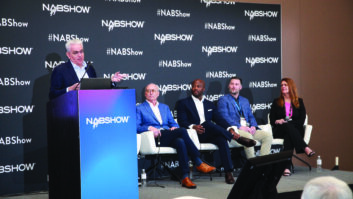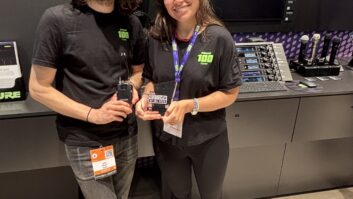
The new generation of small-format digital audio recorders continues a sea change in the way reporters work in the field.
Units are small enough that there is now (this is my news director gene kicking in) no excuse for a radio reporter to be without a professional-quality recorder to record actuality or voice tracks. Some of those small-format digital audio recorders have built-in microphones that will provide pro-quality results for news voice work and music recording. The recorders will fit in a pocket, pouch or purse.
I’ll take a look at four of them and some of their capabilities in this column. Yes, there are more on the market, and keeping up with what’s new is just one of many good reasons to read the new products coverage in Radio World. Tell us about your favorites too.
Familiar name
(click thumbnail)Marantz PMD620The Marantz PMD620 (www.d-mpro.com) is D-M Pro’s SD version of a news recorder. It has onboard stereo microphones, records on SD cards, has a USB 2.0 interface and does not need the AC adapter to function in USB mode, like the Marantz PMD660 (Compact Flash audio recorder).
It runs on two “AA” batteries and records mono and stereo 16- and 24-bit WAV and MP3 files. The 620 has 1/8-inch/3.5 mm TRS line and mic inputs, and can be programmed to recognize which of those are active, and default to the onboard mic if no input is present (useful if a reporter is in a news situation and forgets an external microphone — which happens).
The 620’s onboard software has many of the same features of the 660 menus, such as virtual track selection. My upgrade did not have the 660’s manual recording with limiter control software option. The 620 can be flash upgraded or upgraded online through the USB connection.
The 660 has an onboard speaker for quick monitoring of playback. It uses a thermoplastic holster (which in my evaluation broke after a drop on the ground). The holster has a fitting for a photo tripod. The holster is a good idea; future versions could easily be made from stronger plastic.
(click thumbnail)Edirol R-9Loaded with batteries and an SD card, the 620 weighs around 5 ounces. I used it to record a Danica Patrick news conference for CBS News coverage. If you hear radio reports from Alex Stone of ABC News Radio, you will likely hear some audio recorded on a Marantz PMD620. He uses the 620 for recording voice tracks and actuality.
Alex mentioned that battery life on the 620 when using alkalines was much longer that what is encountered with a Marantz 660 (the 660 uses four “AA” batteries, the 620, two).
Rollin’
The Edirol R-9 (www.rolandus.com) is used as the digital recorder of choice by reporters who cover NASCAR regularly.
The R-9 has onboard mic, records on SD cards, has a USB 2.0 interface, runs on “AA” batteries and records 16- and 24-bit stereo WAV and MP3 files. It has 1/8-inch/3.5 mm mic and line inputs, and a combination headphone/digital output jack. It weighs all of 6 ounces loaded.
(click thumbnail)Steve Richards of the Performance Racing Network, right, uses the Edirol R-9 to record Sprint Cup driver David Reutimann at New Hampshire Motor Speedway.Steve Richards of the Performance Racing Network has been using an Edirol R-9 since the start of the 2007 Sprint Cup Season. He uses the R-9 to record sound in the NASCAR garage area (as in the picture of him and Sprint Cup driver David Reutimann at New Hampshire Motor Speedway).
“Because I deal in large volumes of audio, said Steve, “the ability to download (audio) directly into my laptop (using the Edirol’s USB 2.0 interface) and then into Cool Edit Pro was fantastic.”
Before 2007, Steve used a MiniDisc recorder, and had to dub audio from the MiniDisc in real time into Cool Edit Pro. He likes the battery life, especially when using “AA” lithium batteries.
“In most cases, even under heavy use, the battery life will last up to three race weekends.”
Steve uses a 2 GB SD card for recording. “I was concerned about the design of the download/battery replacement door; especially for other reporters who tend to be rougher on equipment.” By being careful, he’s had no problems.
In future designs, Steve would like to have the ability to erase individual tracks, and perhaps an external speaker.
Little stuff
The MicroTrack II Compact Flash Audio Recorder (www.m-audio.com) was reviewed in Radio World earlier this year by John Gatski (tinyurl.com/6rv7fw).
It has an onboard limiter, balanced 1/4-inch/6.3 mm TRS jacks which can be configured for mic and line inputs, 48 volt phantom power and a USB 2.0 interface, which not only transfers data, it also powers the unit, and recharges the internal battery.
It can be powered from any USB power unit. The unit weighs around 5.5 ounces. The internal battery is not user replaceable, and costs $75 to replace when sent back to M-Audio for the replacement. Battery management with the MicroTrack is crucial.
It records mono or stereo files in 16-bit or 24-bit WAV or MP3 audio files. The MicroTrack II has RCA line and S/PDIF digital outputs. I’ve been using this unit as the mult-box recorder to record news conferences in one location so I can record news makers in another. The option to record in mono helps me to work more quickly. Except that it lacks an onboard speaker, it’s a fully functioning and versatile digital audio recorder.
Olympian aspirations
The Olympus LS-10 (www.olympusamerica.com) records 16- and 24-bit stereo WAV, MP3 and WMA (Windows Media Audio) files. It has 1/8-inch/3.5 mm TRS microphone and line inputs, and has a built-in mic whose sensitivity can be tweaked with internal menus.
(click thumbnail)MicroTrack II These models come with real windscreens that lock on the mic and won’t come off, even if one stuffs the LS-10 in a pocket. The LS-10 has 2 GB of onboard memory, and uses SD cards. It has onboard speakers and a USB 2.0 interface. It runs on two “AA” batteries.
I used the LS-10 to record natural sound and voice tracks at Indianapolis during this year’s Indianapolis 500, recording with both the unit’s internal mics and external mics. The LS-10 has an adapter for a photo tripod and weighs around 5.8 ounces (165 grams). It’s small enough to fit in a hand, so if you’re in a situation where discretion is necessary to get the story, the recording can be made unobtrusively.
With the LS-10 a reporter can use a field expedient to get rid of echoes if you are doing voice tracks in a room with a bed. This involves sitting on the floor, setting the LS-10 down on the bed with the microphones pointing toward the reporter at the proper distance, and speaking toward the microphones. The mattress and blankets will absorb much of the reflected sound.
It may not be elegant but it worked with the LS-10 when I had to do a voice track in a bedroom.
Further thoughts
The MicroTrack II, LS-10 and Edirol are best used as source machines for a laptop or digital audio workstation, but can be used for “wraps” by selecting the beginning of a cut, placing the machine in pause, taking the machine off pause when you want the actuality to come in and stopping the machine when the actuality finishes.
The PMD620 has the Marantz virtual track feature, which means users can select both the in and out points and have the machine play the track on cue, with no effect on the original audio. Most times, the laptop option is much faster. However, if a laptop crashes, this capability means reporters are not stymied and can feed audio through the headphone or line outputs to other devices (land lines, cell phones, loops, standalone codecs, etc.) for editing back at the studio location.
My next column will look at microphones for news work. If you have a favorite microphone, drop me a note to [email protected] and tell me why that microphone works for you as a working radio news reporter.









